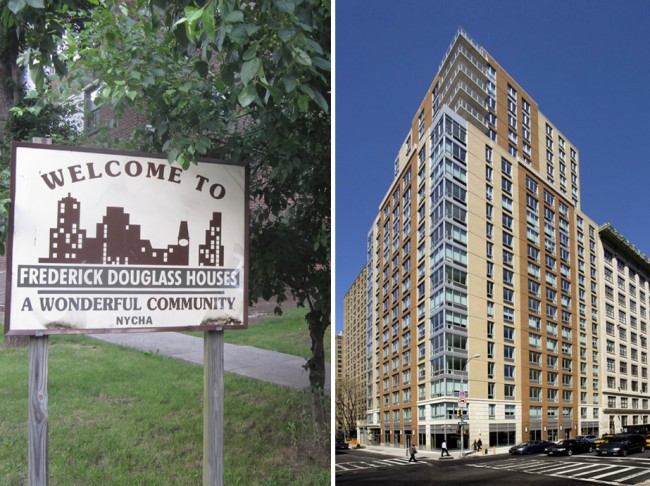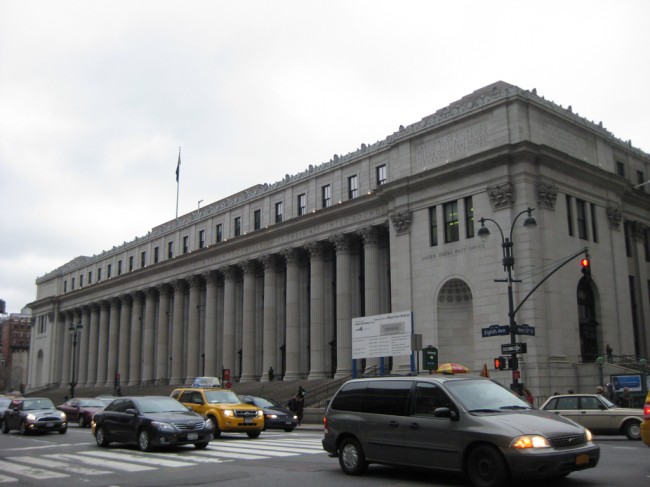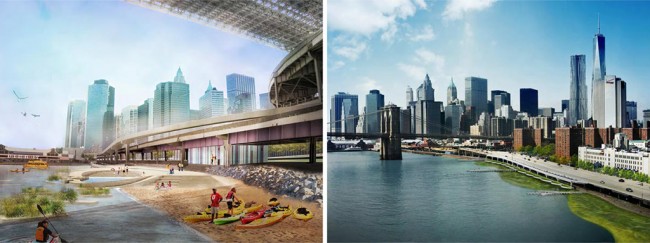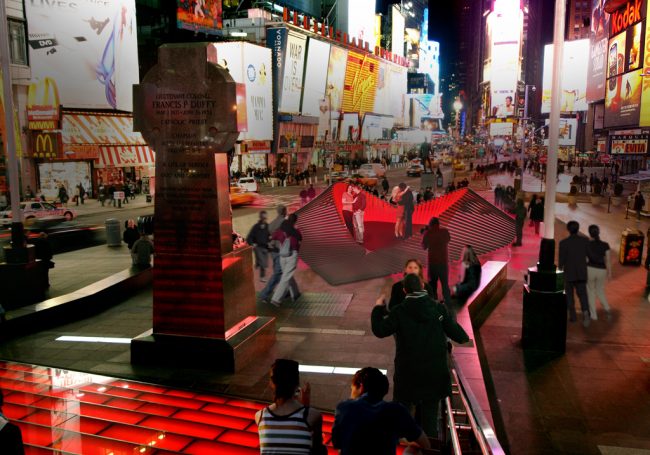
We are celebrating 15 years — and counting — of stories that are deeply researched and deeply felt, that build a historical record of what the city has been.
We are celebrating 15 years — and counting — of stories that are deeply researched and deeply felt, that build a historical record of what the city has been.

Left: Douglass Houses, one of the eight Manhattan properties in the NYCHA proposal Right: Elliot-Chelsea, a recently completed luxury residential project completed on a former NYCHA parking lot as part of a public-private partnership | Images via David X. O’Neil (L) and GF55 Partners (R)
LUXURY TOWERS IN THE PARK
The New York City Housing Authority (NYCHA) is planning to tackle over 400,000 unaddressed repairs and a $60 million annual budget gap by leasing land in public housing projects for private luxury real estate development. Their plan capitalizes on the hot real estate markets around eight Manhattan sites — on the Upper East and West Sides, the Lower East Side, and Lower Manhattan — to build 4,330 new units on land currently used for parking lots, playgrounds, and community centers. Developers would get a 99-year lease, with a property tax break for the first 35 years, in exchange for lease payments and 20% of the units developed as affordable housing. Mayor Bloomberg celebrated the announcement stating, “If you want to have NYCHA buildings be improved and be great places to live, safe and clean and where things function, you’re going to have to have money from someplace.” But the plan will not be carried out until after he leaves office at the end of the year, and several front running mayoral candidates have criticized the deal as too generous and lacking transparency. Political pressure from a new administration might be the only thing that can hold the deal up, as NYCHA does not have to go before community boards when it wants to build on public property.
NBC SHUTS DOWN EVERYBLOCK
Adam Greenfield, author of this week’s feature on Occupy Sandy, sounded a note of caution when Everyblock was first acquired by MSNBC in 2009. On Thursday, Everyblock — a pioneer in hyperlocal data-driven journalism — was abruptly shut down by NBC, leaving city residents without a powerful tool to keep tabs on their neighborhoods. The announcement was made by changing the usually information-rich homepage to an abstract and eerily dark urban skyline, linking to a seven sentence blog post explaining that “within the world of neighborhood news there’s an exciting pace of innovation yet increasing challenges to building a profitable business” and thanking users for “allowing us to connect you to each other, in many cases to make great things happen in your community.”

The James Farley Post Office, potentially one day Moynihan Station | Image via Rose Trinh
HOPE FOR MOYNIHAN STATION
Related Companies is proposing to relocate the Borough of Manhattan Community College (BMCC) to the James Farley Post Office. The redeveloped building — across the street from Penn Station and its 500,000 daily commuters — would include a new train hall, train platforms, and connections to the station. The post office was designed by Beaux Arts masters McKim, Mead & White, the same architects as the original Penn Station. Transforming the post office into a new home for Penn Station — first proposed by Senator Moynihan in the early 1990s — is largely understood to be an effort to atone for tearing down the celebrated old Penn Station and replacing it with the current, claustrophobic transit hub beneath Madison Square Garden. College and state officials, whose approval is required to complete the land swap, have had a lukewarm response to placing the growing school in the building. In Related’s proposal, the developer would acquire the four blocks of valuable downtown real estate on which the BMCC now sits.
HUDSON YARDS’ CULTURE SHED
On Monday, the City’s Department of Cultural Affairs presented new detailed plans for the Culture Shed, the keystone cultural piece of the Hudson Yards development slated for construction on 30th Street next to the High Line. The building — designed by Diller Scofidio + Renfro and Rockwell Group — is envisioned as a kunsthalle, an art space without a permanent collection, with a series of flexible spaces able to host visual and performing arts from various local and international cultural establishments. A retractable canopy will double the size of the ground-floor gallery when deployed. Promoters of the project claim it will provide a space for exhibits and programs that are currently unmountable within the city’s existing institutions. The city hopes to have the institution open by 2017.

East River Blueway | Images via Manhattan Borough President’s Office
EAST RIVER BLUEWAY PLAN
In his final State of the Borough address, Manhattan Borough President Scott Stringer officially announced the East River Blueway Plan. The plan aims to develop more public amenities, like beaches and boat launches, to allow residents to access and get into the water. For a discussion of the process of designing the plan, check out our interview with Adam Lubinsky, managing principal at WXY Architecture + Urban Design, one of the firms working with the borough president’s office to create the plan.
MTA FUNDS DIVERSION
Although less dramatic than the diversion of approximately $260 million from the MTA’s budget to other uses in 2009 and 2010, the Tri-State Transportation Campaign notes that Governor Cuomo plans to dip into funds dedicated for MTA operating needs, to the tune of $20 million, to pay for debt service of previously issued MTA bonds. Transit advocates note the recurring nature of such hidden cuts, which come just a over a month before fares are set to rise.
A PLACE TO LIVE
The Chicago Film Archives has uncovered a fascinating film commissioned by the Chicago Department of Urban Renewal in 1968. A Place to Live explains (and defends) urban renewal efforts in Chicago which, as in nearly every American city at the time, cleared out entire neighborhoods in the name of “progress” and “revitalization.” Decades later, popular opinion generally agrees that such efforts did more harm than good, but seeing the argument made at the time provides a lens to understand the decisions that reformed entire neighborhoods, not only in Chicago, but also in almost every mid-century American city.
SANDY
With the first installment of the federal Sandy aid package released, Governor Cuomo is proposing to spend $400 million on a home buyout program for people living in flood-prone areas. The New York Times outlines the key points: “Residents living in flood plains with homes that were significantly damaged would be offered the pre-storm value of their houses to relocate; those in even more vulnerable areas would be offered a bonus to sell; and in a small number of highly flood-prone areas, the state would double the bonus if an entire block of homeowners agreed to leave.” Ultimately, Cuomo hopes to incentivize homeowners in flood-prone areas to move inland. Local authorities will then decide on how to use the land, either restoring natural coastlines to act as a storm buffer or developing public parks. The buy-outs woud be voluntary and the proposal has garnered a warm response from some homeowners.
Mayor Bloomberg has yet to respond directly to the Governor’s plan, but on Wednesday he announced plans of his own to implement Sandy recovery programs funded with $1.77 billion in federal grants allotted to New York City. The initiatives fall into three categories: housing recovery, business recovery, and infrastructure resiliency. Housing will claim the majority of the funds ($720 million), but Bloomberg also plans to open up three “Race-to-the-Top”-style competitions (in reference to the Obama administration’s education programs that replaced the No Child Left Behind strategies of the Bush administration), allocating grants to the most innovative and cost-effective ideas for resiliency products and technologies that can be replicated citywide, investment ideas for spurring long-term economic growth, and measures for utilities to protect critical networks.

Rendering of Heartwalk in Times Square | Image via Times Square NYC
EVENTS AND STUFF TO DO
HEARTWALK
Last month, Situ Studio won the Times Square Valentine Heart Design Competition, and the team has been hard at work building the installation ever since. Inspired by the collective devastation following Hurricane Sandy, Situ used salvaged wooden planks from destroyed beach boardwalks, removed the nails and screws, brushed off the salt and sand, cut off splintered areas, and planed the planks to assemble Heartwalk. They explain, “the installation begins as two ribbons which fluidly lift from the ground to form a heart shaped enclosure in the middle of Duffy Square.” A flattened area allows visitors to enter the heart, where they can capture a rare moment of pause in the busy city. The installation will go up on Tuesday and will remain on view until March 8th. Check out our conversation with the Situ team about designing for public assembly here.
TRIANGLE FIRE MEMORIAL DESIGN COMPETITION
The Remember the Triangle Fire Coalition (RTFC) is seeking entries for a two-stage international design competition to honor the victims and legacy of the 1911 Triangle Shirtwaist Factory Fire. The memorial will be located on the exterior of the Manhattan building where this historic fire occurred and “should recall not just the tragedy and every worker who perished, but also reflect the unique importance of the many workers’ rights movements, safety laws, and social welfare policies that resulted from this fire.” Visit the competition website for more information, including submission instructions, design requirements, and site details. Registration is open through March 29, 2013.
BRACKET [GOES SOFT] LAUNCH PARTY
[Bracket], an annual publication by Archinect and InfraNet Lab that explores the intersection of architecture, environment, and digital culture, will release its second volume tonight at Studio-X NYC. This year’s theme is [goes soft], which examines “soft” (i.e. adaptable, responsive, non-linear) immaterial systems, structures, and networks today. The book launch will also feature presentations and discussions with some of the editorial advisors and contributors to the volume, including Michael Chen, who shared his research into the significance of broadcast and antenna infrastructure on the physical environment of the city in this UO feature.

From “What’s In The Water?” | Image via CUP
WHAT’S IN THE WATER? LAUNCH PARTY
With hydraulic fracturing — or, “fracking” — drawing ever greater attention, the Center for Urban Pedagogy (CUP) has created What’s In The Water?. As part of CUP’s Making Policy Public poster series, this latest piece explains the fracking process and its impact on the food and water supplies of New York City. Al Appleton, a Senior Fellow at the Cooper Union Institute for Sustainable Design, and Barry Estabrook, a writer on issues of food safety and justice, will discuss the effects of fracking on Wednesday, February 13th (7pm) at The Cooper Union. RSVP to info@welcometocup.org by Monday at 5pm.
KOCH, THE MOVIE
In the wake of former Mayor Ed Koch’s passing last week, learn more about his three terms as mayor, the challenging times during which he served, and the colorful man himself in the new documentary Koch, playing at Angelika Film Center through Thursday, February 14th.
The Roundup keeps you up to date with topics we’ve featured and other things we think are worth knowing about.
The views expressed here are those of the authors only and do not reflect the position of The Architectural League of New York.